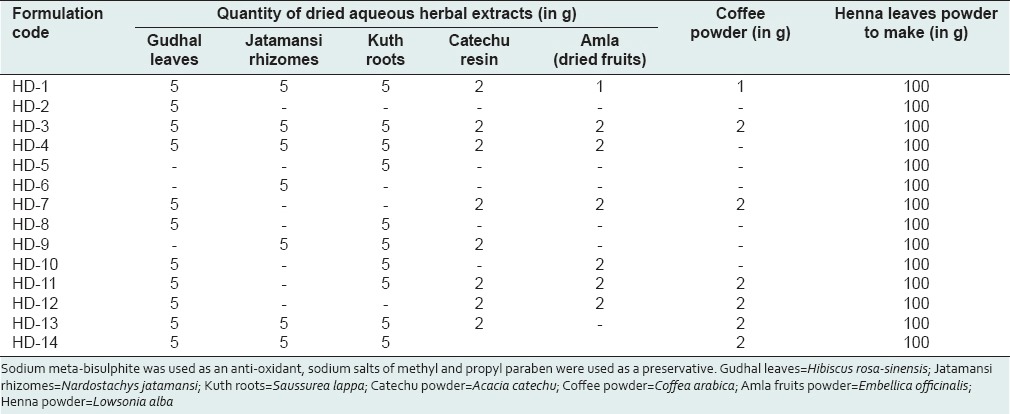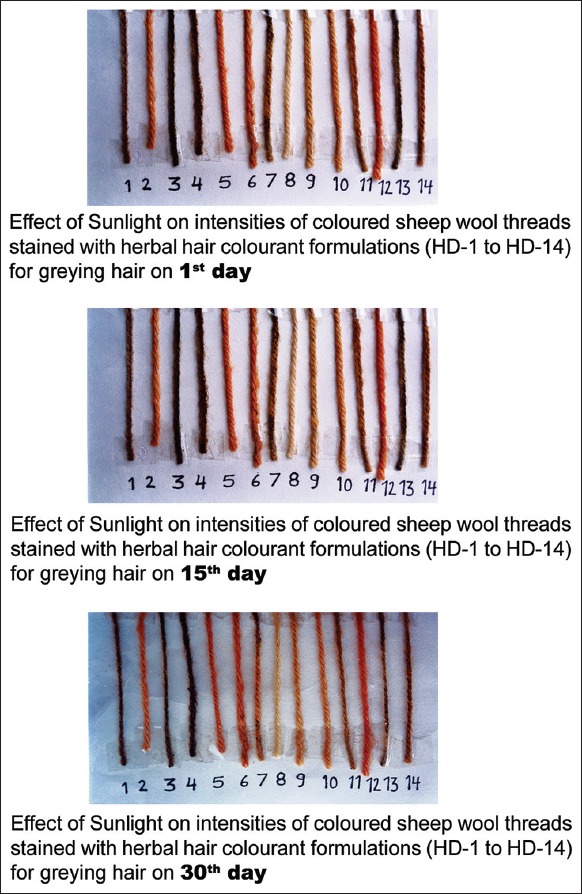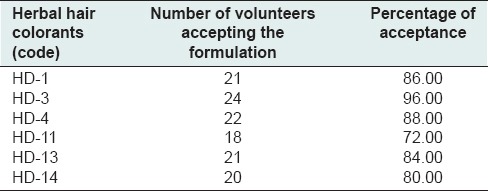Abstract
Objective:
To screen the hair colouring properties of hair colorants/ herbal hair colouring formulations.
Materials and Methods:
The dried aqueous herbal extracts of Gudhal leaves (Hibiscus rosa-sinensis), Jatamansi rhizome (Nardostachys jatamansi), Kuth roots (Saussurea lappa), Kattha (Acacia catechu), Amla dried fruit (Embelica officinalis), were prepared. Coffee powder (Coffea arabica) and Henna powder (Lowsonia inermis) were taken in the form of powder (# 40). Fourteen herbal hair colorants were prepared from these dried aqueous herbal extracts and powders. Activities of hair colorants were observed on sheep wool fibers. On the basis of the above observation six hair colorants were selected. These six formulations were taken for trials on human beings.
Observation:
The formulation coded HD-3 gave maximum colouring effect on sheep wool fibers as well as on human beings and percentage of acceptance among the volunteers were in the following order: HD- 3 > HD- 4 > HD-1 > HD-13 > HD-14 > HD-11.
Results and Discussion:
The remarkable results were obtained from five herbal hair colorants, viz., HD-1, HD- 3, HD- 4, HD-13 and HD-14 on sheep wool fibers and human beings. Formulation HD-3, having gudhal, jatamansi, kuth, kattha, amla, coffee and henna, was the maximum accepted formulation and suggested that these herbs in combination acts synergistically in hair colouring action. It also concluded that jatamansi, present in different hair colorants, was responsible to provide maximum blackening on hair
Keywords: Colorant formulations, Human hair, Natural hair, Sheep wool fibers
INTRODUCTION
The desire to look beautiful is human weakness and is as old as the origin of human being itself. Today most of the human beings are very careful about their beauty and hairs play an important role in this. Herbal drugs without any adverse effects are used for healthy hair. About 70% of human beings above the age of 50 years face balding and graying of hair. In some, these symptoms of age arrive much earlier. Graying starts on the scalp at about 40 years first at the temples, follows later by the beard and moustache and still later the chest. The age at which hair of a person turns gray is largely decided by heredity. But premature loss of pigment in adults may be caused by a variety of other factors, including illness, certain drugs, wariness, even shock and it is irreversible. However, if hair turns white in childhood, it can be a result of malfunction in the body and medical advice is called for.[1,2]
Hibiscus rosa-sinensis is prescribed as hair and beared colorant.[3] Nardostachys jatamansi is used for blackening of hair.[4,5] In the beginning, the growth of hair is sparse and its colour lighter. In about 1 or 2 years, the growth of hair becomes thick and the colour darker. Natural herbal hair colorants/formulations contain dried fine powder or dried aquous/organic solvent extracts used to colour the hair.
Preparations used in the hair care are available in the form of creams, dyes, pomades, powders, tonics, lotions, conditioners, wave set, hair sprays, rinsers etc. The herbal drugs are used as hair colorants.[3,4,5,6] More than hundred hair formulations are available in the Indian market. Few of them contain between <5 herbal drugs where as most of the formulations contain more than five herbal drugs.[7,8,9] In hair colorants, herbs can be used in the form of powder, aqueous extract or their seed oil to impart shades of different colour varying from reddish brown to blackish brown.[10,11,12]
This paper describes the development of a herbal hair colorants/formulations from N. jatamansi, Saussurea lappa, H. rosa-sinensis, Lawsonia inermis, Acacia catechu, Coffea arabica, Embelica officinalis.
MATERIALS AND METHODS
Plant materials
The fresh H. rosa-sinensis leaves were collected from South Delhi, fresh rhizomes of N. jatamansi were collected from the hilly area of Pauri Garhwal, Uttaranchal, India. Kattha, dried Amla, dried roots of S. lappa were purchased from Khari Baoli market, Delhi. The fresh leaves of henna leaves were collected from a Farmhouse near Jaipur, Rajasthan, and coffee powder was purchased from local market.
All the plants material were authenticated by Dr. M. P. Sharma, Reader and Taxonomist, Department of Botany, Faculty of Science, Jamia Hamdard (Hamdard University), New Delhi. Voucher specimens are deposited in the Herbarium of Phytochemical Research Laboratory, Faculty of Pharmacy, Jamia Hamdard (Hamdard University), New Delhi.
Preparation of aqueous herbal extracts
The air-dried, course pulverized herbal drugs (5 kg each) were extracted with distilled water. The aqueous extracts so obtained were dried under vacuum to get dark brown masses (residues obtained varies from 24% to 62% w/w).
Preparation of herbal hair colorants
Fourteen herbal hair colorants were prepared by mixing dried aqueous herbal extracts and powdered herbs (passed through #40), in sufficient quantity of distilled water to make uniform viscous paste. Sufficient quantities of anti-oxidants and preservatives were also added.[13,14] All the formulated herbal hair colorants were kept in airtight containers at 10°C. The quantities (% w/w) of dried herbal extract used in these hair formulations are tabulated in Table 1.
Table 1.
Composition of herbal hair colorant formulations

Preparation of natural detergent
A 30% w/v solution of reetha was prepared by boiling reetha pericarp with distilled water for half an hour. The extract was filtered and used as a natural detergent for washing of coloured sheep wool fibers.[9,10]
Patch test
A small quantity of each hair formulation was applied on the back portion (skin) of the ear. After 15 min of application, the skin was observed carefully. All the formulations were free from allergic reactions to human skin and rabbit skin. No itching, redness and rashes have been observed from the formulated hair care formulations.
Application of the herbal hair colorants on bleached sheep wool fibers
The natural bleached sheep wool fibers were collected from Ludhiana market, Punjab, India. The wool fibers were cut into small pieces (15 cm). Each wool fibres defatted with Petroleum ether (40°C–60°C). The five wool pieces were dipped into each formulation kept in a beaker for 1 h, air-dried and washed with tape water. The washed coloured wool fibers were divided into three categories to observe the effects at room temperature, in sunlight and washing with a natural detergent.[15]
Effect of room temperature on coloured wool fibers
The coloured wool fibers were pasted on a white paper sheet, covered with transparent cellophane sheet and then kept for 30 days at room temperature. Photographs of this sheet were taken at an interval of 0, 5, and 30 days [Slides 1–3].
Effect of sunlight on coloured wool fibers
The coloured wool fibers were pasted on a white paper sheet, covered with transparent cellophane sheet and kept in day sunlight for 2 h daily for 30 days. Photographs of this sheet were taken at an interval of 0, 15, and 30 days [Slides 4–6, Figure 1].
Figure 1.

Effect of sunlight on intensity of coloured wool hair on Day 7th,15th and 30th
Effect of natural detergent on coloured of wool fibers
The coloured wool fibers were washed with aqueous reetha (soap nut) extract for 5 min on alternate days for 30 days and then air-dried after each washing. Photographs of these wool fibers were taken at an interval of 0, 15, and 30 days [Slides 7–9].
Effect of herbal hair colorants on human volunteers
On the basis of the above studies, six herbal hair colorants, viz., HD-1, HD-3, HD-4, HD-11, HD-13 and HD-14 were selected out of 14 hair formulations. Each hair colorant was applied to the hair of a group of 25 volunteers (15 males and 10 females). The hair were air dried for more than 2 h, washed off with tape water and watched carefully for different shades of hair colour.
All these six formulations were used on volunteers only after getting negative patch test.
RESULTS
Out of the fourteen hairs colorant formulations, six herbal hair colorants viz. HD-1, HD-3, HD-4, HD-11, HD-13 and HD-14, were selected for clinical trials. The maximum colouring effect was observed with HD-3. The colorant and colour on wool fibers after treatment with HD-3 remained for the maximum days, when these kept at room temperature, in sun light and washed with the natural detergent. The intensities of colour on these fibers by herbal hair colorants were observed in the order: HD-3 > HD-4 > HD-1 > HD-13 > HD-14 > HD-11.
There was no change in colour of wool fibers when kept at room temperature for 60 days, whereas the colour of wool fibers got faded in sunlight gradually and after a period of 15 days it remained half of the original colour. It indicated that ultraviolet rays present in sunlight affected the colour of wool fibers produced by herbal hair colorants. The washing of wool fibers with reetha extract (a natural detergent) on alternate days did not effect quickly on coloured fibers. The half of original colour remained on these fibers even after 20 days, but wool fibers got completely faded within 35 days. The colour of wool fibers dipped in HD-11 got completely faded within 30 days. In cases of other herbal hair colorants, the colour of the fibers started to fade after 25 days. The colour intensities of fibers with hair colorants HD-13 and HD-14 became half in 15 days, where as colour intensities of wool fibers with hair colorants HD-1 and HD-4 have become half in 22 days. The colour intensity of wool fibers with hair colorant HD-3 has become half in 30 days and completely faded in 52 days. These six herbal hair colorants were tested on six groups of volunteer of different age group and sex having 20 volunteers in each group. The herbal hair colorant was applied to hair of the volunteers, air dried for 2–3 h and then hair were washed with tape water. The colours of hair were observed daily for each group till the complete removal of colour from the hair. All the herbal hair colorants were well accepted and percentage of acceptance were calculated from results and opinions obtained from the volunteers [Table 2]. The herbal hair colorant HD-3 was most accepted among the volunteers and percentage of acceptance was 96%. The percentage of acceptance of the formulated hair colorants were in the order: HD-3 > HD-4 > HD-1 > HD-13 > HD-14 > HD-11.
Table 2.
Volunteers acceptance percentage for the various herbal hair colorant ormulations

DISCUSSION
The remarkable results were obtained from five natural herbal hair colorants viz. HD-1, HD-3, HD-4, HD-13 and HD-14 were obtained when tested on the hair of human. All the hair colorants were well accepted and percentage of acceptance varied from 80% to 96%. The maximum acceptance percentage (96%) was obtained from HD-3 hair colorants. All these hair colorants exhibited good results when applied on sheep wool fibers and on human hair. Present studies suggested that the HD-3, having H. rosa-sinensis (Gudhal), N. jatamansi (Jatamansi), S. lappa (Kuth), L. inermis (Henna) showed potent hair colouring effects as compared to HD-4, having same ingredients as in HD-3 except henna. This also suggested that these three herbs in combination with henna acted synergistically in hair colouring action. The hair colorants with jatamansi herb showed remarkable hair colouring effect. It was concluded that jatamansi was responsible to provide maximum dark colouring effect on hair and the blackening of hair by natural herbal hair colorants was totally depend upon the presence of jatamansi. All the fourteen herbal hair colorants were found to be effective against dandruff. L. inermis, N. jatamansi (Jatamansi) and S. lappa (Kuth) are recommended as hair colouring agents in traditional practice also and they are also proved effective colouring agents in this research.[16] Nowadays there are various methods are adopted for obtaining dyes from Henna and Hibiscus and their speed and methodology of dyeing was evaluated using standard dyes.[17,18] Some of the dyeing substances are identified as lawson is found in Henna and chemically these are anthraquinone or napthaquinone dyes.[19] So in future research may be carried out for isolation of pigments for more efficient hair dyeing agents.
AKNOWLEDGEMENTS
The authors are thankful to Hon'ble Vice Chancellor, UPTU, Lucknow and Dr. R. C. Sharma, Chairman, Ram-eesh Institute of Voc. and Tech. Edn. Greater Noida for their positive attitude towards research.
Footnotes
Source of Support: Nil
Conflict of Interest: None declared.
REFERENCES
- 1.Kumar S, Akhila A, Naqvi AA, Farooqi AH, Singh AK, Uniyal GC, et al. Medicinal Plants in Skin Care. Lucknow, India: CIMAP; 1994. pp. 425–30. [Google Scholar]
- 2.Orfanos CE, Happle R. Hair and hair diseases. Germany: Spring-veriang Berlin Heidelberg; 1990. pp. 19–44. [Google Scholar]
- 3.Wealth of India, Raw materials. Vol. 1. New Delhi: Publication and Information Directorate (CSIR); 1997. Anonymus. [Google Scholar]
- 4.Kitrikar K, Basu BD. Indian Medicinal Plants. 2nd ed. Vol. I. Allahabad: L. M. Basu; 1993. pp. 335–6. [Google Scholar]
- 5.Chopra RN, Nayar SL, Chopra IC. Glossary of Indian Medicinal Plant. New Delhi: CSIR; 1956. [Google Scholar]
- 6.Ambasta ST. Useful Plants of India. New Delhi: PID, CSIR; 1986. [Google Scholar]
- 7.Sharma L, Agrawal G, Kumar A. Medicinal plants for skin and hair care. Indian J Tradit Knowl. 2003;2:62–8. [Google Scholar]
- 8.Punjani BL, Kumar V. Plants used in traditional phytotherapy for hair care by tribals in Sabarkantha district, Gujarat, India. Indian J Tradit Knowl. 2003;2:74–8. [Google Scholar]
- 9.Mitaliya KD, Bhatt DC, Patel NK, Dodia SK. Herbal remedies used for hair disorders by tribals and rural folk in Gujarat. Indian J Tradit Knowl. 2003;2:389–2. [Google Scholar]
- 10.Upadhyay VP, Mishra AK. Workshop on selected medicinal plants. Bombay: Ministry of Commerce, Chemexcil; 1985. [Google Scholar]
- 11.Upadhyay VP. Current Research in Ayurvedic Medicine (International Seminar) Chicago, USA: Himalayan Institute; 1980. [Google Scholar]
- 12.Upadhyay VP. International Seminar on Medicinal Plants. Mungpoo, Govt. of West Bengal: Publication and Information Directorate, CSIR, New Delhi; 1985. Plants as cosmetics. [Google Scholar]
- 13.Lindley H. The chemical composition and structure of wool. In: Lindley H, editor. Chemistry of Natural Protein Fibers. New York: Plenum; 1977. pp. 147–91. [Google Scholar]
- 14.Sharma PP. A Comprehensive Book on Cosmetics Formulation, Manufacturing and Quality Control. Delhi: Vandana Publications; 1998. [Google Scholar]
- 15.The Ayurvedic Formulary of India, Part-I (Second Revised English Edition) New Delhi: Govt. of India, Ministry of Health and Family Welfare, Dept. of Indian System of Medicine and Homoeopathy; 2003. Anonymus; p. 3. [Google Scholar]
- 16.Kapoor VP. Herbal cosmetics for skin and hair care. Nat Prod Radiance. 2005;4:306–14. [Google Scholar]
- 17.Ali R, Sayeed SA. A plant dye from Lawsonia inermis for protein staining after polyacrylamide gel electrophoresis. Electrophoresis. 1990;11:343–4. doi: 10.1002/elps.1150110414. [DOI] [PubMed] [Google Scholar]
- 18.Bose S, Nag S. Isolation of natural dyes from the flower of Hibiscus rosa-sinensis. Am J PharmTech Res. 2012;2:762–70. [Google Scholar]
- 19.Jan HU, Shinwari ZK, Khan AA. Staining effect of dye extracted from dry leaves Of Lawsonia inermis linn (Henna) on angiospermic stem tissue. Pak J Bot. 2011;43:383–9. [Google Scholar]


